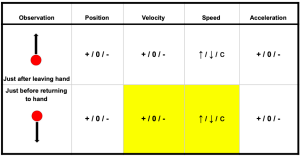Exercise 3: Ball Thrown Up
Instead of dropping the object from the height of 1.0 m, let’s imagine you throw the object straight up into the air. Think about what happens to the ball the second after it has left your hand and is moving up versus the second before it returns to your hand and is moving down, which is described by the first and second scenarios depicted in the table below. For this exercise, we will set our coordinate system so that the origin is at the ground and upwards is the positive direction. Note: We are not taking any measurements with this exercise but discussing things qualitatively.
Exercise 3.1 (1 mark)
Fill in the chart by circling one of each:
+ (positive) / 0 (zero) / – (negative)
and
↑ (increasing with time) / ↓ (decreasing with time) / c (constant with time)
Remember: Velocity and acceleration have a magnitude and direction.
On Crowdmark choose the correct version(s) of the table.

Exercise 3.2 (1 mark)
a. The velocity is zero and the speed is decreasing since the object is experiencing a constant negative acceleration.
b. The velocity is negative and the speed is decreasing since the object is experiencing a constant positive acceleration.
c. The velocity is positive and the speed is constant.
d. The velocity is zero and the speed is increasing since the object is experiencing a constant negative acceleration.
e. The velocity is negative and the speed is increasing since the object is experiencing a constant negative acceleration.
Before you continue!
Before continuing, be sure you have completed Exercises 3.1 and 3.2 on Crowdmark for grading.
